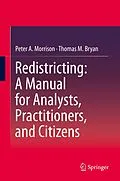This comprehensive manual provides a user-oriented overview of U.S. Census data and demographic methods for redistricting applications. It addresses current issues and concerns accompanying the creation, adjustment, and evaluation of election districts and plans that incorporate them using 2020 Federal Census data. It meets the needs of local governments, citizen redistricting commissions, parties to litigation, and practitioners using Census data for political redistricting. The book provides many examples of technical problems that analysts will encounter when applying these data, supplemented by extensive case studies illustrating these technical issues and how they can be addressed. The book is a source to consult for insight, background, and concrete examples of specific issues and concerns and how to address them. As such this comprehensive reference manual is a "must have" for applied demographers, data scientists, statisticians, citizen redistricting commissions, parties to litigation, practitioners, and any analyst or organization engaged in political redistricting using US decennial census data.
Autorentext
Peter A. Morrison is an applied demographer, retired from the RAND Corporation where he was the founding director of RAND's Population Research Center. His principal interests are redistricting and, more generally, the analysis of demographic trends and their consequences for public policy and business. He has taught at the University of Pennsylvania, the RAND Graduate School, and the Helsinki School of Economics. He has been elected as President of the Southern Demographic Association and as a Director of the Population Association of America.
Thomas M. Bryan is a data scientist and former Census Bureau statistician, with extensive experience using Census Bureau data.
Inhalt
Foreword
Preface
Chapter 1: Introduction & Overview
Chapter 2: Background, Context, and Key Issues
Chapter 3: Using This Reference ManualPart I: DATA AND METHODS
Chapter 4: Overview of Data Used in Redistricting
Chapter 5: Building a Redistricting Database
Chapter 6: Special Purpose Demographic Accounting Models
Part II: PROFILING LOCAL DEMOGRAPHIC CONTEXTS
Chapter 7: characterizing and illustrating local contextsChapter 8: Group's intrinsic voting strength
Chapter 9: Techniques for contrasting the spatial distributions
Chapter 10: Senate Factor 5 Lingering effects of discriminationPart III: EVALUATING AND COMPARING PLANS
Chapter 11: Legal considerations
Chapter 12: Specific concerns in comparing statewide redistricting plansPart IV: CASE STUDIES
Chapter 13: Overview of part IV
Chapter 14: Integrating Administrative, Political, and Statistical GeographyChapter 15: Disparities between Total and Eligible Voter Populations
Chapter 16: Distinguishing False Positives Among Majority-minority Election Districts in Statewide Congressional Redistricting
Chapter 17: Accounting for Postcensal Population Change
Chapter 18: Accounting for Prisoner Populations:
Chapter 19: Balancing Representational & Electoral Equality
Chapter 20: Balancing traditional redistricting criteria
Chapter 21: Evaluating Minority Voting Strength in Spatially Diverse Contexts
Chapter 22: Discerning Statistical Imprints of Intent
Chapter 23: Foreseeing Hispanics' Potential Future Voting StrengthChapter 24: Senate Factor 5 Evaluation
Chapter 25: Characterizing Local Demographic Contexts
